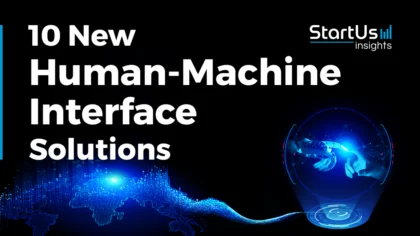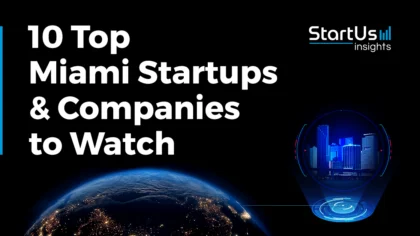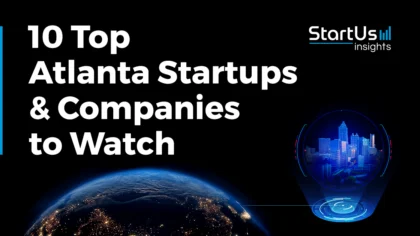Human-machine interaction bridges the gap between advancements in modern technology and practical applications. This list of 10 human-machine interface solutions features solutions spanning industries. These solutions include voice recognition software that converts user commands into actionable tasks and virtual reality (VR) systems that immerse individuals in digital worlds. Businesses leverage these technologies to enhance operational efficiency and foster customer engagement. Ultimately, these HMI solutions benefit society by making technology more accessible, intuitive, and beneficial for all users. Our latest update of this report was 5 days ago. If you find a mistake or missing information, tell us!
Continue reading to gain up-to-date and data-driven insights on:
- Profiles of 10 Emerging Human-Machine Interface Solutions
- How to Scout New Human-Machine Interface Solutions Easily
Key Takeaways
Drawing insights from the Big Data & AI-powered StartUs Insights Discovery Platform that provides data on over 4.7+ million emerging companies globally, we explore the evolving landscape of the HMI industry. This sector is marked by key trends and a substantial workforce, shaping its future. Here are some key insights at a glance:
- Latest Human-Machine Interaction Trends: Some of the top 10 trends in the human-machine interaction industry are intuitive app design, neurotechnology, voice assistants, and text-to-speech solutions.
- HMI Industry Stats: The global human-machine interaction industry encompasses 28K+ organizations and has a massive 1.1M workforce. It is experiencing an annual growth of 5.26% and has seen the emergence of 1K+ new human-machine interface companies in the past five years.
- 10 New Human-Machine Interaction Companies to Watch:
- Ixana – Wireless Interfaces
- Aavaa – Brain-Machine Interfaces
- Algorized – Radar Sensing
- Kinemo – Wearable Controllers
- BioX – Motion Detection
- Neuranics – Neurotechnology Interfaces
- ONTBO – AI Human-Machine Interaction
- Perceived – 3D Visualization
- NeuralEcho Labs – Brain Monitoring
- InnoBrain – Human Cognitive Monitoring
Discover 10 out of 1K+ Emerging HMI Companies
In this section, we highlight 10 top human-machine interface solutions leading to innovative machine interface solutions. These companies are responding to user concerns and evolving market demands. By pioneering brain interfaces, new voice assistants, smart presence sensors, and 3D visualization interfaces, these companies are setting new standards.
Note on Signal Strength
One of the unique metrics we feature for each company is Signal Strength, a proprietary data point generated by our Discovery Platform. It gauges the extent to which a company’s influence has permeated the global ecosystem of startups, scaleups, and emerging companies. This proprietary metric serves as a valuable guidepost for understanding a company’s standing in the broader market landscape.
1. Ixana
- Founding Year: 2020
- Employee Range: 11-50
- Location: USA
- Signal Strength: Very Strong
- What they do: Ixana advances human-computer interaction through its Wi-R (a non-radiative near-field communication) technology. It encapsulates signals within the user’s electric surface to ensure private data transmission and eliminate external access. Wi-R offers an improvement in energy efficiency over traditional Bluetooth and Wi-Fi, promoting longer device life and sustainability. The technology features touch selectivity as well as high-speed and low-power touch detection. It supports a range of applications, including charging-free wearables, real-time health dashboards, and augmented reality (AR) smart glasses. Users benefit from increased security through touch-based authentication for payments and system access.
2. Aaavaa
- Founding Year: 2019
- Employee Range: 11-50
- Location: Canada
- Signal Strength: Very Strong
- What they do: Aaavaa develops NeuroPong, a device that converts brain and bio-signals into actionable commands for electronic devices. It deciphers auditory and visual attention along with user intent through subtle gestures like blinks and winks. The device also utilizes multiple microphones and speech enhancement to operate effectively. Additionally, attention-tracking technology monitors head orientation, eye direction, and auditory focus. The company’s hardware design prioritizes miniaturization and ergonomic considerations, making the technology accessible and user-friendly. Aaavaa’s HMI technology benefits individuals with paralysis.
3. Algorized
- Founding Year: 2022
- Employee Range: 2-10
- Location: Switzerland
- Signal Strength: Very Strong
- What they do: Algorized offers an ultra-wideband radar sensing technology for human presence detection. The company’s sensors utilize signal processing algorithms to enable real-time positioning and tracking. They also detect presence through obstacles, enhancing their utility in various environments. Additionally, the technology supports vital signs detection and monitoring breathing and heart rate. Algorized’s technology further refines radar signals for optimal performance and reliability, benefitting industries requiring sophisticated monitoring and security systems.
4. Kinemo
- Founding Year: 2023
- Employee Range: 2-10
- Location: USA
- Signal Strength: Medium
- What they do: Kinemo provides wearable alternative controllers for individuals with limited upper extremity mobility. Custom tracers are attached to any sufficiently mobile body part like the head or fingers. These tracers transmit motion data to the company’s device, Connect, which then facilitates control of digital devices. Connect operates through Bluetooth and ensures compatibility with various mobile platforms and computers. The controller also supports integration with several power wheelchair models to support individuals diagnosed with tetraplegia.
5. BioX
- Founding Year: 2019
- Employee Range: 2-10
- Location: Denmark
- Signal Strength: Strong
- What they do: BioX makes advanced sensing technologies for limb motion detection. Its product, BioX Sensor Band, combines biomechanics, robotics, and machine learning to accurately detect arm and leg movements, strength, and gestures. The band also classifies gestures and sends controller signals to actuators. It thus finds application in controlling exoskeletons and as a human-machine interface for research and educational purposes. Professionals in robotics, education, and rehabilitation benefit from the precision and convenience these bands offer.
6. Neuranics
- Founding Year: 2021
- Employee Range: 2-10
- Location: Scotland
- Signal Strength: Very Strong
- What they do: Neuranics develops MAGNABLE, a neurotechnology-based interface for human-computer interaction. The company’s wearable and implantable interfaces leverage sensing microsystems for bionic device enhancement. These interfaces facilitate direct communication between human neural systems and computers, offering control and feedback. The company uses magnetomyography to capture high-resolution muscle activity without invasive procedures. This benefits individuals requiring prosthetic limbs by enhancing their ability to perform tasks with higher precision.
7. ONTBO
- Founding Year: 2021
- Employee Range: 2-10
- Location: France
- Signal Strength: Very Strong
- What they do: ONTBO makes a responsible AI platform for enhancing human-machine interactions. The company’s affective computing-based technology uses facial detection, audio analysis, and digital trace analysis to accurately perceive user emotions. ONTBO’s platform, in this way, enables businesses to create hyper-personalized experiences across various sectors including automotive, banking, fintech, retail, and esports. In vehicles, the company’s AI analyzes driver emotions in real time using non-intrusive sensors, improving safety and comfort. Similarly, it assists advisors by analyzing customer emotions through chatbot interactions in banking.
8. Perceived
- Founding Year: 2019
- Employee Range: 11-50
- Location: India
- Signal Strength: Very Strong
- What they do: Perceived’s platform enables users to create and share 3D interactive human-computer interaction interface modules. It focuses on immersive training, 3D assessments, and interactive content without requiring coding skills. The platform also features demonstrative teaching tools to facilitate interactive and immersive learning. Additionally, the platform offers solutions for remote demonstrative training and patient education in the healthcare sector. Industries such as automotive and industrial training also benefit from tailored maintenance and repair training modules.
9. NeuralEcho Labs
- Founding Year: 2023
- Employee Range: 2-10
- Location: UK
- Signal Strength: Weak
- What they do: NeuralEcho Labs develops advanced brain-computer interfaces to detect the K-complex waveform in EEG during sleep. Additionally, it aids neurologists in diagnosing and treating epilepsy more effectively. The multi-sensorial system also detects driver drowsiness to increase vehicular safety and potentially reduce accidents caused by driver fatigue. With the use of wavelet compression of EEG data, the company ensures efficient data storage and processing, which is crucial for real-time monitoring applications.
10. InnoBrain
- Founding Year: 2019
- Employee Range: 2-10
- Location: Sweden
- Signal Strength: Medium
- What they do: InnoBrain provides an AI-enabled brain-computer interface to enhance human cognitive monitoring. It operates alongside a cognitive data platform to monitor driver and operator performance. Additionally, the company’s comfort analytics utilizes biomarkers to assess and elevate comfort for all users in various mobility scenarios to improve safety and efficiency.
Quick Tip to Find New Human-Machine Interface Companies
Utilizing a SaaS platform like the Discovery Platform for identifying new HMI solutions provides significant benefits compared to traditional scouting methods:
- Streamlined Efficiency: The Discovery Platform offers advanced tools that streamline the scouting process. It replaces your hours of conventional desk research, saving time and resources in identifying human-machine interaction innovations.
- Access to Real-time Insights: Gain a competitive edge with up-to-date information on the latest trends in the HMI industry. The platform keeps you informed with near real-time updates on emerging human-machine interface companies and news, enabling you to make swift and informed decisions.
- Tailored Exploration: Customize your search to focus on specific niches within the HMI sector, such as gesture control, brain interfaces, or emotion recognition. The platform’s diverse filtering options allow you to target your scouting efforts precisely, ensuring that you find the most relevant and groundbreaking companies in the field.
Ready to Explore All New HMI Companies?
This overview highlights just a few HMI solutions from all 1K+ new companies currently covered by the Discovery Platform. To explore them all, book a personalized demo or download one of our free Industry Innovation Reports for a quick overview. We’re keen to partner with subject matter experts to enrich our coverage. Think you can help? Let us know.










